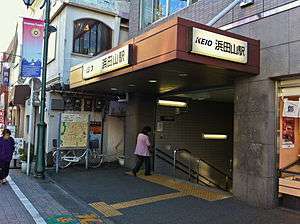Hamadayama Station
Hamadayama Station (浜田山駅, Hamadayama-eki) is a railway station on the Keio Inokashira Line in Suginami, Tokyo, Japan, operated by the private railway operator Keio Corporation.
Hamadayama Station 浜田山駅 | |
|---|---|
 Station entrance, November 2012 | |
| Location | Suginami, Tokyo Japan |
| Operated by | Keio Corporation |
| Line(s) | Keio Inokashira Line |
| Connections |
|
| Other information | |
| Station code | IN11 |
| History | |
| Opened | 1933 |
| Traffic | |
| Passengers (FY2011) | 28,169 daily |
Lines
Hamadayama Station is served by the 12.7 km Keio Inokashira Line from Shibuya in Tokyo to Kichijōji. Located between Nishi-Eifuku and Takaido, it is 7.5 km from the Shibuya terminus.[1]
Service pattern
Only all-stations "Local" services stop at this station. During the daytime, there are eight services per hour in either direction.
Station layout
The station consists of a single ground-level island platform serving two tracks.[2]
Across the tracks at both the Kichijoji and Shibuya ends are pedestrian crossings. The ticket gates are at ground level, but there is only an entrance on the north side of the tracks. In order to enter the station from the south side, one must first use a pedestrian crossing to the north side.
The station was rebuilt in 1995, moving the station building underground, and extending the length of the platform, coinciding with the introduction of the Keio 1000 series, with trains of five 20 m cars. Before the rebuilding, there was a road crossing the tracks within the area that trains stopped in at the station.
Platforms
| 1 | ■ Keio Inokashira Line | for Kugayama and Kichijōji |
| 2 | ■ Keio Inokashira Line | for Shimo-Kitazawa, Meidaimae, and Shibuya |
Adjacent stations
| « | Service | » | ||
|---|---|---|---|---|
| Keio Inokashira Line (IN11) | ||||
| Express: Does not stop at this station | ||||
| Nishi-Eifuku (IN10) | Local | Takaido (IN12) | ||
History
The station opened on 1 August 1933.[1]
From 22 February 2013, station numbering was introduced on Keio lines, with Hamadayama Station becoming "IN11".[3]
Passenger statistics
In fiscal 2011, the station was used by an average of 28,169 passengers daily.[4]
The passenger figures for previous years are as shown below.
| Fiscal year | Daily average |
|---|---|
| 1999 | 25,935[1] |
| 2010 | 28,285[4] |
| 2011 | 28,169[4] |
Surrounding area
As of February 2016, there was a large number of supermarkets near the station compared to other stations on the Inokashira Line, including Comodi Iida, My Basket, Seiyu, and Seijo Ishii.
References
- Terada, Hirokazu (July 2002). データブック日本の私鉄 [Databook: Japan's Private Railways]. Japan: Neko Publishing. p. 206. ISBN 4-87366-874-3.
- Kawashima, Ryozo (April 2010). 日本の鉄道 中部ライン 全線・全駅・全配線 第1巻 東京駅―三鷹エリア [Railways of Japan - Chubu Line - Lines/Stations/Track plans - Vol 1 Tokyo Station - Mitaka Area]. Japan: Kodansha. pp. 13, 54. ISBN 978-4-06-270061-0.
- 京王線・井の頭線全駅で「駅ナンバリング」を導入します。 [Station numbering to be introduced on Keio Line and Inokashira Line] (PDF). News release (in Japanese). Keio Corporation. 18 January 2013. Retrieved 25 March 2013.
- 1日の駅別乗降人員 [Average daily station usage figures] (in Japanese). Japan: Keio Corporation. 2013. Retrieved 25 March 2013.
- Tokyo Toyotama High School website. Retrieved 25 March 2013. (in Japanese)
- Tokyo Suginami General High School website. Retrieved 25 March 2013. (in Japanese)
External links
| Wikimedia Commons has media related to Hamadayama Station. |
- Hamadayama Station information (Keio) (in Japanese)